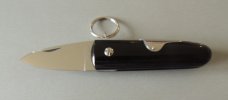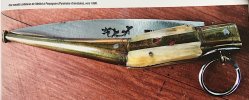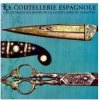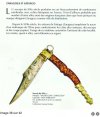-
The BladeForums.com 2024 Traditional Knife is ready to order! See this thread for details: https://www.bladeforums.com/threads/bladeforums-2024-traditional-knife.2003187/
Price is $300 ea (shipped within CONUS). If you live outside the US, I will contact you after your order for extra shipping charges.
Order here: https://www.bladeforums.com/help/2024-traditional/ - Order as many as you like, we have plenty.
You are using an out of date browser. It may not display this or other websites correctly.
You should upgrade or use an alternative browser.
You should upgrade or use an alternative browser.
what’s the idea behind the French coup de poing?
- Thread starter Mark_McM
- Start date
- Joined
- Feb 9, 2015
- Messages
- 4,083
Looks like a knife Jacques Mongin might have made. Well, or one of the few who still make knives of his design, in a small shop in Nogent, France.
Located in Biesles (Nogent), France, a small shop of artisans painstakingly create the edged works of art designed by master cutler, Jacques Mongin.
The winner of the prestigious MOF (Meilleurs Ouvriers de France – Best Craftsmen of France) award in 1965, Jacques has recently retired, but his son, Daniel Margaux, has taken over and maintains this cutlery icon’s legacy.
Jacques Mongin was also a designer and maker of knives for Hermès.
Do a google image search for Jacques Mongin, coup de poing and several similar ones will pop up.
If you can find no marks on the knife, try removing the pivot screw to remove and examine the hidden part of the blade. Sometimes, there are maker's marks around the pivot hole in the blade. Might need a magnifying glass or jewelers loupe and might find a small oval that says ... FORGE MAIN (hand-forged) ... J.M. ... NOGENT INOX (Nogent Stainless).
If I'm wrong ... because all this was just a guess ... nevermind
EDIT: Here's what came up on Duck Duck image search ... Jacques Mongin, coup de poing
Located in Biesles (Nogent), France, a small shop of artisans painstakingly create the edged works of art designed by master cutler, Jacques Mongin.
The winner of the prestigious MOF (Meilleurs Ouvriers de France – Best Craftsmen of France) award in 1965, Jacques has recently retired, but his son, Daniel Margaux, has taken over and maintains this cutlery icon’s legacy.
Jacques Mongin was also a designer and maker of knives for Hermès.
Do a google image search for Jacques Mongin, coup de poing and several similar ones will pop up.
If you can find no marks on the knife, try removing the pivot screw to remove and examine the hidden part of the blade. Sometimes, there are maker's marks around the pivot hole in the blade. Might need a magnifying glass or jewelers loupe and might find a small oval that says ... FORGE MAIN (hand-forged) ... J.M. ... NOGENT INOX (Nogent Stainless).
If I'm wrong ... because all this was just a guess ... nevermind
EDIT: Here's what came up on Duck Duck image search ... Jacques Mongin, coup de poing
Last edited:
kamagong
Gold Member
- Joined
- Jan 13, 2001
- Messages
- 10,874
What's coup de poing? Are you talking about the ratcheting ring lock knife? I think they're also known as palm knives in France, due to the locking system on the back of the handle that has the shape of a palm leaf. They're not only made in France though. The best known example of this design is the Okapi.
Here's one that was made by Friedrich Herder.


Here's one that was made by Friedrich Herder.


- Joined
- Feb 9, 2015
- Messages
- 4,083
What's coup de poing?
... Punch
kamagong
Gold Member
- Joined
- Jan 13, 2001
- Messages
- 10,874
I've got nothing.... Punch
- Joined
- Feb 9, 2015
- Messages
- 4,083
While the OP's knife looks "newer", the Coup de Poing has been made for quite some time.
This is not my knife, but an example of a vintage fancy one made in Nogent in the last part of the 19th or early 20th century.

This is not my knife, but an example of a vintage fancy one made in Nogent in the last part of the 19th or early 20th century.

screened porch
Basic Member
- Joined
- Feb 19, 2012
- Messages
- 18,368
Coup de poing/ punch meaning the whole knife is for sticking/stabbing?
- Joined
- Feb 9, 2015
- Messages
- 4,083
If it is a Jacques Mongin, here is some info that might help date it ... At least prior or subsequent to the late 1980's ...
The blade tang stamped * Forge Main / JM / Nogent Inox * within in an oval ... Until the end of the 1980s, the signature in an oval was preceded by the words "Forgé Main", which has subsequently and until today been replaced by the words "Fait Main".
The blades are now laser cut and no longer shaped in the forge. They are rather more efficient and consistent than before, but "Hand Forged" markings are rarer and more expensive than "Handmade" markings.
And again, you may have to remove the blade and look around the pivot hole in the blade for marks.
The blade tang stamped * Forge Main / JM / Nogent Inox * within in an oval ... Until the end of the 1980s, the signature in an oval was preceded by the words "Forgé Main", which has subsequently and until today been replaced by the words "Fait Main".
The blades are now laser cut and no longer shaped in the forge. They are rather more efficient and consistent than before, but "Hand Forged" markings are rarer and more expensive than "Handmade" markings.
And again, you may have to remove the blade and look around the pivot hole in the blade for marks.
- Joined
- Aug 28, 2019
- Messages
- 47
That thing is positively magnificent.Looks like a knife Jacques Mongin might have made. Well, or one of the few who still make knives of his design, in a small shop in Nogent, France.
Located in Biesles (Nogent), France, a small shop of artisans painstakingly create the edged works of art designed by master cutler, Jacques Mongin.
The winner of the prestigious MOF (Meilleurs Ouvriers de France – Best Craftsmen of France) award in 1965, Jacques has recently retired, but his son, Daniel Margaux, has taken over and maintains this cutlery icon’s legacy.
Jacques Mongin was also a designer and maker of knives for Hermès.
Do a google image search for Jacques Mongin, coup de poing and several similar ones will pop up.
If you can find no marks on the knife, try removing the pivot screw to remove and examine the hidden part of the blade. Sometimes, there are maker's marks around the pivot hole in the blade. Might need a magnifying glass or jewelers loupe and might find a small oval that says ... FORGE MAIN (hand-forged) ... J.M. ... NOGENT INOX (Nogent Stainless).
If I'm wrong ... because all this was just a guess ... nevermind
EDIT: Here's what came up on Duck Duck image search ... Jacques Mongin, coup de poing
Jolipapa
Basic Member
- Joined
- Jun 4, 2015
- Messages
- 6,108
Also known as cra-cra, Eustache etc.. it is a way older pattern than Okapi, a peasant's knife made everywhere in France, Nogent, Nontron, Coupe du rasoir-Lézard, Couvreux 23, Au Lion, St Joanis in Thiers, J. Charasse in Perpignan, Henseling in Toulon. This was one of the most produced pattern and 46000 were requisitioned to be issued to French soldiers in 1914 until 1915.

No need to dismantle. It is a Mongin, sole maker today. It exists in 6,8 and 10cm (closed length) and various materials. Quite dangerous if you do't have the knack to close it. Maybe the name comes in that it is safer to close it pushing the blade against something solid while opening the ratchet.If it is a Jacques Mongin, here is some info that might help date it ... At least prior or subsequent to the late 1980's ...
The blade tang stamped * Forge Main / JM / Nogent Inox * within in an oval ... Until the end of the 1980s, the signature in an oval was preceded by the words "Forgé Main", which has subsequently and until today been replaced by the words "Fait Main".
The blades are now laser cut and no longer shaped in the forge. They are rather more efficient and consistent than before, but "Hand Forged" markings are rarer and more expensive than "Handmade" markings.
And again, you may have to remove the blade and look around the pivot hole in the blade for marks.

Okapi began producing knives in Germany in 1902, but I don’t know if the classic ratchet knife was among the first offerings. I suspect it may have been, since it was apparently a popular pattern at least in France around that time. Do you know about when the earliest examples of the couteau à palme appeared, and where?Also known as cra-cra, Eustache etc.. it is a way older pattern than Okapi,
- Joined
- Feb 9, 2015
- Messages
- 4,083
Okapi began producing knives in Germany in 1902, but I don’t know if the classic ratchet knife was among the first offerings. I suspect it may have been, since it was apparently a popular pattern at least in France around that time. Do you know about when the earliest examples of the couteau à palme appeared, and where?
They likely appeared in France shortly after the Spanish incorporated that rachet lock on their Navaja knives in the 19th century.
But before the Spanish refined the lock system, they were using a similar but crude version on the Navaja in the 1700's.
The development of technologies did not stand still and by the middle of the XVIII century, the Navajas began to be equipped with the first locks. Those were springs located in the upper part of the handle, when opened, exerting pressure on the heel of the blade. Such a lock was technologically similar to a modern slip joint lock. A knife with this lock could not withstand high loads on the blade and be used for heavy work. This forced the Spanish masters to show their ingenuity and go a little further, developing the first real lock for the Navaja. It was a lock with a blade fixation through a hole in the spring with a protrusion in the form of a prong located on the upper part of the blade. This protrusion was inserted into the hole and the blade was fixed quite reliable. To open such a knife, a small lever was used, which allowed to bend the spring. In the XIX century, the springs of such a lock received an additional ring, which improved the convenience of folding the knife.

Spanish Navaja knife. History and modernity
Now whether or not the French would agree with that history or origin of anything to do with their knives is a whole 'nother thing
Jolipapa
Basic Member
- Joined
- Jun 4, 2015
- Messages
- 6,108
At first Okapi produced kitchen knives as the company was purveyor of metallic kitchen gears, the folders came later for export to Afrika (ex-SouthWest Africa now Namibia was a German colony). The ratchet may have come to Germany when Alsace and Lorraine were occupied after 1870. I'm no specialist in german cutlery.Okapi began producing knives in Germany in 1902, but I don’t know if the classic ratchet knife was among the first offerings. I suspect it may have been, since it was apparently a popular pattern at least in France around that time. Do you know about when the earliest examples of the couteau à palme appeared, and where?
The palme appeared toward the end of XVIIIth century, more or less at the same period as the mouche (at first the mouche was a ratchet without ring, not a slipjoint).
A navalla made circa 1800 in Perpignan by Mellot. ( Mr Lamasson's Couteaux de France)

B brother Jim : This "Spanish" knife was built in Thiers probably after 1900, script is Corsican. The author of the article seems to be, hmm, a bit confused... Navaja is not a pattern, simply means knife.
Thiers litterally overflowed Spain with their products in the XIXth, sometime giving it a Spanish sounding name. In couterpart they had the cheapest knives made for them in Spain.
For those interested https://www.lecouteau.info/coup-d-oeil-sur-l-etranger/espagne/#
(in the page click on the cover to read the complete booklet of the Albacete museum's exposition in Thiers and Solingen in 2007 that gives a good insight of the Spanish cutlery.)


( museum of Albacete booklet) Navajas produced (in Zaragoza & Sastago) show many similarities with those made in France. It is most probable that many of them originate from there, though the marks indicate Zaragoza as the city of distribution.
Last edited:
- Joined
- Aug 28, 2019
- Messages
- 47
Hello All,
Interesting stuff. Actually, I was curious about the small version "punch" knife (coup de poing) as shown in my opening post (and later pictured by BrotherJim and Jolipapa) specifically, what is the purpose of this rather diminutive knife? Or is it just a small version of the larger counterpart? Also, Jolipapa: that photo of the person in uniform wearing the knife on his belt and holding a small automatic pistol... can you provide the whole photo for context?? I have one of these larger versions (which was sold to me as a "cheese knife" ). Have also found at least two additional photos of French troops with this knife. Very interesting...
). Have also found at least two additional photos of French troops with this knife. Very interesting...
Interesting stuff. Actually, I was curious about the small version "punch" knife (coup de poing) as shown in my opening post (and later pictured by BrotherJim and Jolipapa) specifically, what is the purpose of this rather diminutive knife? Or is it just a small version of the larger counterpart? Also, Jolipapa: that photo of the person in uniform wearing the knife on his belt and holding a small automatic pistol... can you provide the whole photo for context?? I have one of these larger versions (which was sold to me as a "cheese knife"
Attachments
Jolipapa
Basic Member
- Joined
- Jun 4, 2015
- Messages
- 6,108
Well, what is the purpose of a small Elefant toe or canoe? No idea. The 10cm would be too bulky for me and the other too small (notwhitstanding they're not cheap!)Hello All,
Interesting stuff. Actually, I was curious about the small version "punch" knife (coup de poing) as shown in my opening post (and later pictured by BrotherJim and Jolipapa) specifically, what is the purpose of this rather diminutive knife? Or is it just a small version of the larger counterpart? Also, Jolipapa: that photo of the person in uniform wearing the knife on his belt and holding a small automatic pistol... can you provide the whole photo for context?? I have one of these larger versions (which was sold to me as a "cheese knife"). Have also found at least two additional photos of French troops with this knife. Very interesting...
No sorrry there's the credit where I found it but it is all I got. Anyway, in the French Army no picture at all was allowed during WWI on the real front, all the movies and pictures are official fakes to keep civilian's morale up.
Thanks for the excellent info as always.At first Okapi produced kitchen knives as the company was purveyor of metallic kitchen gears, the folders came later for export to Afrika
Here is a catalog page from the late 1940s showing the ratchet knife, from the catalogs section of the site you linked. Interesting that the 907 and 1907 model numbers are the same numbers used today.

https://www.lecouteau.info/catalogues/okapi-vers-1945-49/
If you click on the smaller thumbnails under the large images, it brings up a really cool gallery.
- Joined
- May 4, 2015
- Messages
- 76
Hello! You seem to have some funny looking palm trees growing in your neighbourhood! Concerning the name " couteau a palme ", it seems that it comes from an ancient way of measuring. Like " foot " = 12 inches, " une pouce " a thumb = 1 inch. " Palme " = the average width of a palm " 9 cm. or 3.5 inches. In french " palmer " something is the action of hiding something in your hand, whereas " paumer " is to missplace or lose something. Don´t the height of horses get mesured in palms or in England by hands ? I don´t know when palme changed into paume, but this seems the most logic explanation of the term " couteau a palme ". Have a nice day, Michel Droz.What's coup de poing? Are you talking about the ratcheting ring lock knife? I think they're also known as palm knives in France, due to the locking system on the back of the handle that has the shape of a palm leaf. They're not only made in France though. The best known example of this design is the Okapi.
Here's one that was made by Friedrich Herder.


Jolipapa
Basic Member
- Joined
- Jun 4, 2015
- Messages
- 6,108
At school you would be granted an off-topic! Question is "why a coup-de-poing"?Hello! You seem to have some funny looking palm trees growing in your neighbourhood! Concerning the name " couteau a palme ", it seems that it comes from an ancient way of measuring. Like " foot " = 12 inches, " une pouce " a thumb = 1 inch. " Palme " = the average width of a palm " 9 cm. or 3.5 inches. In french " palmer " something is the action of hiding something in your hand, whereas " paumer " is to missplace or lose something. Don´t the height of horses get mesured in palms or in England by hands ? I don´t know when palme changed into paume, but this seems the most logic explanation of the term " couteau a palme ". Have a nice day, Michel Droz.
I also slightly disagree with some of your assertions. See your MP for details
- Joined
- May 4, 2015
- Messages
- 76
The question is " why a coup-de-poing "? Off topic? You show a picture of " A navalla made circa 1800 in Perpignan by Mellot ". Ben d´accord, qu´es qu´un couteau nord Catalan a en rapport avec un coup de poing Mongin fabriqué a Nogent ? Et je vous ferait remarquer que Mongin n´as jamais fabriqué un " cra-cra " non plus.....hors sujet? And why send me information on my profile? Maybe other knife fans would like to be informed. MD.At school you would be granted an off-topic! Question is "why a coup-de-poing"?
I also slightly disagree with some of your assertions. See your MP for details
Last edited:
cbach8tw
Gold Member
- Joined
- Jan 9, 2006
- Messages
- 12,159
So, if I understand, the ring is to help to pull the back spring or just slightly bend the spring to remove the tension on the tang of the blade? Is there a hole in the spring where a notch on the tang of the blade slips into the hole when open?
Last edited:




